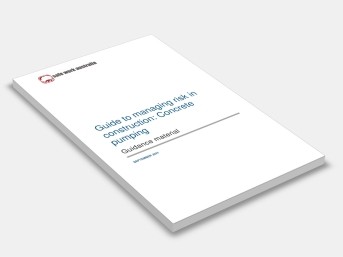Guide to managing risk in construction: Concrete pumping
Safe Work Australia
SEPTEMBER 2021
Concrete pumping is the transportation of a freshly mixed batch of concrete via a system of pipes to a specific location on a construction site. Concrete pumping is a widely used process in the construction industry. It can be used to manufacture pre-cast and tilt up concrete panels, concrete formwork, slab construction, concrete paving and concrete spraying.
Equipment used in concrete pumping includes the following:
Line Pump: Use of a fixed or mobile pump that pumps concrete through pipes and/or flexible hoses that run along the ground
Mobile Concrete Placing Boom: Use of a truck-mounted pump to pump concrete through pipework that is supported by a multi-staged boom
Satellite Concrete Placing Boom: Use of a fixed or trailer-mounted pump to pump concrete through pipework to a concrete placing boom fixed to the structure being built
Concrete is normally delivered to the concrete pump using a concrete truck that dispenses concrete into the hopper on the pump, which is then pushed through pipework to the location of the concrete pour. Concrete pumping is generally a more efficient means of delivering concrete in comparison to the use of a wheelbarrow or crane-lifted concrete kibble. However, due to the high pressure involved and the pulsating motion of the pump, there can be significant safety risks associated with pumping concrete.
Generally, concrete pumping work is defined as construction work. It may also be considered high risk construction work under the Work Health and Safety (WHS) Regulations. A safe work method statement (SWMS) must be prepared before high risk construction work starts.
This Guide is intended to supplement other information produced by Safe Work Australia to assist you to meet your duties and obligations under WHS laws. It should be read in conjunction with the following:
-
Model Code of Practice: How to manage work health and safety risks
-
Model Code of Practice: Managing the risks of plant in the workplace, and
-
Model Code of Practice: Construction work.
Safe Work Australia
